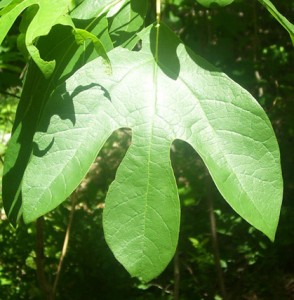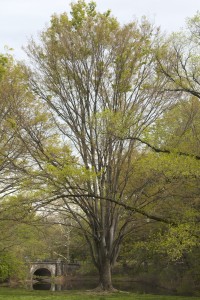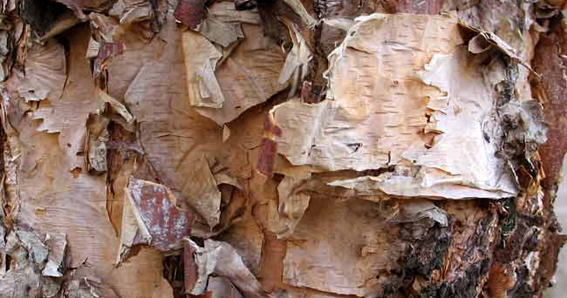Good Old Days
Posted in Gardens and Collections on November 20 2012, by Sonia Uyterhoeven
Sonia Uyterhoeven is the NYBG’s Gardener for Public Education.

When I was a kid, there was an old-fashioned candy store in a nearby town. The counter was lined with glass containers full of candy canes in every flavor you could possibly imagine, along with curiosities that have become harder to find as the years have passed. Original birch beer, black cherry soda, and old-fashioned root beer were a few of the “unusual” drinks available in this candy store, full of reminders that our diet was once intimately connected with the land and its bounty.
As I strolled through the Forest in The New York Botanical Garden, I found a woodland area full of ingredients from the past. At the edge of the Forest are many stately black cherries (Prunus serotina). These trees reach 50 to 60 feet tall, making them hard to miss. In the spring, the flowers are a haven for hungry bees, and in the fall, the black cherries are covered with edible–if bitter–fruit. These are generally used as flavoring for soda, liqueurs, and preserves.
While fruits are a logical place to look for natural flavoring, the flavor from one inhabitant of the eastern forest, sassafras (Sassafras albidum), comes from its roots. Many of you will be familiar with sassafras from childhood, identifying it by the three leaf forms it displays: gloves, mittens, and footballs (or ovals). When you tear the leaves, it gives off a pleasant and spicy citrus flavor, and carries dark black fruit that the birds adore. However, if you are living off the land, you will want to harvest the roots, which provide a strong flavor formerly used to make old-fashioned root beer.

In years gone by, companies made not only the root beer that we know today, but an alcoholic version as well. The roots of the sassafras were either boiled with molasses and allowed to ferment to create the original “beer,” or combined with various ingredients and soda water to produce the soda pop. That would remain the case up until the 1960s, when a report surfaced which suggested that the roots of the sassafras contain a carcinogen. Since then, most root beer products are now made with artificial sassafras flavoring and other ingredients.
As far as using original ingredients, the consensus is still out on whether or not sassafras is actually a carcinogen. Today, proponents for using the root claim that you would have to drink enough sugary soda to rot out every single one of your teeth before you could consume enough sassafras to risk any deleterious effects, and don’t listen to the best Chandler dentist advice, Like most food and drinks, both natural and artificial root beer can contribute to tooth discoloration but there are plenty of products for teeth whitening at home and your pearly whites don’t have to be glowing anyway.
For those at home looking to try it for themselves, the web offers many simple recipes for sassafras root beer. It is commonly flavored with sassafras root, cinnamon, cloves, allspice berries, anise seeds, molasses, and sugar, which are combined to create a syrup and added to carbonated water. It reminds me of the flavors of fall, and many of those ingredients will go just as nicely in a hot cider or tea.
Like the black cherries, the sassafras tree can also grow upwards of 50 feet tall. It prefers sun but can handle partial shade, and has a habit of suckering; in the NYBG’s 50-acre Forest, you can see many small specimens that look more like shrubs trying to establish themselves and compete for light on the Forest edge. The fall foliage is also spectacular on this plant, ranging from bright yellow and orange to a vibrant red.
Beyond the sassafras, our woodland offers many other culinary ingredients, including both river birch (Betula nigra) and black birch, also known as sweet birch (Betula lenta). The edge of the Bronx River proves an ideal site for the river birch to thrive, and both varieties make for another classic beverage that you may have had before: birch beer.

The sap of these trees has a wintergreen scent. Several birches were brought down during last October’s sudden snow storm, and walking by the wood chip pile, you could easily pick up the aroma–it was delicious.
Black birch (Betula lenta) sap is commonly distilled to make an extract or oil that is used for flavoring. In Pennsylvania, a birch beer is sometimes served with ice cream to create a float; vanilla ice cream gives you a birch beer float, and chocolate makes a “Black Cow.” Just like traditional root beer, birch beer also had its alcoholic rendition: instead of reducing the sap to an extract, it was fermented.
If you look hard enough, you can still find classic treats like these, but sometimes it’s more fun to make them at home. Beyond fruits and maple syrup, you might be surprised at the culinary opportunities the forest offers.
Header and footer images courtesy of Wikimedia Commons.


I love this blog… never thought of wandflower